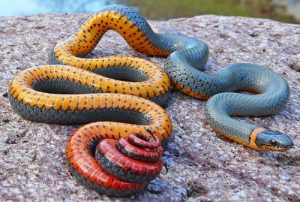Ringneck Snake
The ringneck snake is a species of slender, mildly poisonous snakes commonly found in southeastern Canada, central Mexico, and many parts of the US. Their small stature, nonaggressive nature, and rear-facing fangs do not pose much threat to the humans. Females are comparatively larger while having shorter tails than the males.
Scientific Classification
| Kingdom | Animalia |
| Phylum | Chordata |
| Subphylum | Vertebrata |
| Class | Reptilia |
| Order | Squamata |
| Suborder | Serpentes |
| Family | Colubridae |
| Subfamily | Dipsadinae |
| Genus | Diadophis |
| Scientific Name | Diadophis punctatus |
Quick Information
| Other Names | Ring-necked snake |
| Subspecies | Fourteen are recognized; some of them are northern ringneck snake (D. p. edwardsii), regal ringneck snake (D. p. regalis), southern ringneck snake (D. p. punctatus), prairie ringneck snake (D. p. arnyi), coral bellied ringneck snake (D. p. pulchellus) and northwestern ring-necked snake (D. p. occidentalis) |
| Size | Adults: 10 to 15 in (25 to 38 cm) Juveniles: About 8 in (20 cm) |
| Weight | 1.32 g on average |
| Color | Solid olive, bluish gray, black, and brown with red, yellow-orange, or yellow neck band; some may lack the distinctive band; red or yellow-orange ventral coloration with black spots |
| Distribution | Nova Scotia, southern Ontario and Quebec in Canada; Gulf of Saint Lawrence, Gulf Coast of Texas, southern Florida, northern Minnesota, eastern Nebraska, Iowa, Kansas, Pacific Northwest, south-central Washington, western Idaho, southern Nevada, central Utah, Arizona; central Mexico |
| Habitat | Woodlands, forests, chaparrals, grasslands; riparian and arid regions, abandoned buildings, junk piles; also in seasonally wet places |
| Lifespan/Life Expectancy | 10-20 years; 6 years in captivity |
| Diet | Small lizards, earthworms, salamanders, frogs, slugs, young ones of other snake species |
| Communication/Perception | Head rubbing, touching, pheromones |
| Adaptations | Western ringnecks secrete a musky saliva with a pungent odor to escape predators when held |
| Number of offspring | 3-10 eggs |
| Breeding season | Spring or fall |
| Eggs hatch | August or September |
| Predators/Competition | Blue racers, kingsnakes, coral snakes, shrews, skunks, armadillos, opossums, screech owls, bullfrogs, wild hogs; large centipedes and spiders eat baby ringneck snakes |
| IUCN Conservation Status | Least Concern |
Behavior
Ring-necked snakes are secretive reptiles that do not usually expose themselves to the daylight. Diurnal activity is sometimes observed, particularly on cloudy days when they lie exposed to the sun to gain heat.
They exhibit social structure with some populations existing as colonies of more than 100 individuals. Some snake communities are often found occupying a single microhabitat.
When in danger, ring-necked snakes with orange-red posterior raise their coiled tails toward the predators to warn them of their toxicity.
Mating and Reproduction
During the mating season, female snakes release pheromones from the skin to attract males. Once attracted, the male rubs his mouth along the body of the female snake, bites her around the neck ring and aligns his body with the female’s to release the sperm. In some subspecies, delayed fertilization may occur, with the eggs being laid during June-July in moist, aerated regions.
Life Cycle
After the eggs are laid, there is no parental involvement in caring for the eggs. The young snakes are somewhat mobile and mature from the moment they hatch. They reach sexual maturity at 3 years of age.
Interesting Facts
- To secure its prey, the ringneck snake compresses and then injects venom into the victim’s body.
- Instead of having true venom glands, the ringneck snakes possess the Duvernoy’s gland that might help in swallowing or digestion.
References
Published on December 7th 2016 by admin under Coniferous Forest Animals.
Article was last reviewed on 9th May 2023.












